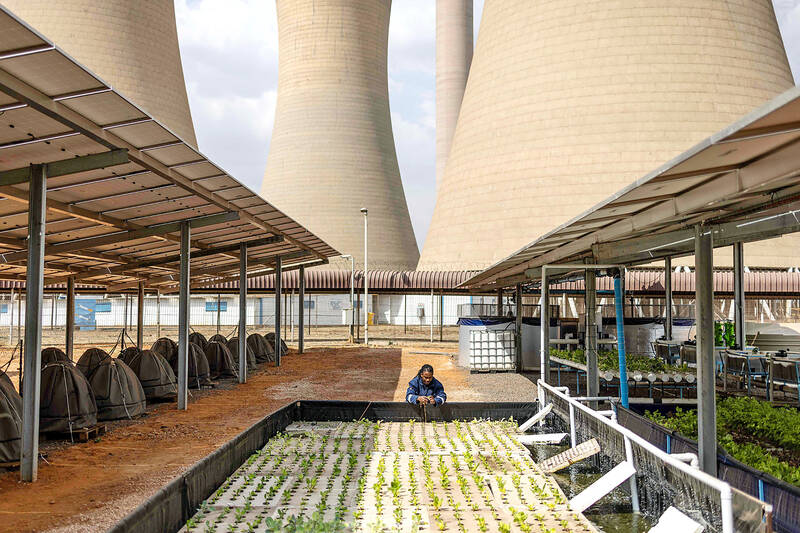The cold corridors of South Africa’s once-mighty Komati coal-fired power plant have been quiet since its shutdown in 2022 in what was trumpeted as a pioneering project in the world’s transition to green energy.
Two years later, plans to repurpose the country’s oldest coal power plant have amounted to little in a process that offers caution and lessons for countries intending to reduce their reliance on fossil fuels and switch to renewables.
Jobs have been lost and construction for wind and solar energy generation has yet to start, with only a few small green projects under way.

Photo: AFP
“We cannot construct anything. We cannot remove anything from the site,” acting general manager Theven Pillay said at the 63-year-old plant embedded in the coal belt in Mpumalanga province, where the air hangs thick with smog.
Poor planning and delays in paperwork to authorize the full decommissioning of the plant have been the main culprits for the standstill, he said.
“We should have done things earlier. So, we would consider it is not a success,” he said.
Before it turned off the switches in October 2022, the plant fed 121 megawatts (MW) into South Africa’s chronically undersupplied and erratic electricity grid. The transition plan — which won US$497 million in funding from the World Bank — envisions the generation of 150MW via solar and 70MW from wind, with capacity for 150MW of battery storage.
Workers are to be reskilled and the plant’s infrastructure, including its massive cooling towers, repurposed.
However, much of this is still a long way off.
“They effectively just shut down the coal plant and left the people to deal with the outcomes,” South African Deputy Minister of Energy and Electricity Samantha Graham said.
Coal provides 80 percent of South Africa’s power, and the country is among the world’s top 12-largest greenhouse gas emitters. Coal is also a bedrock of its economy, employing about 90,000 people. South Africa was the first country to form a just energy transition partnership (JETP) with international funders to move off dirty power generation, already receiving US$13.6 billion in total in grants and loans, South African presidential JETP committee member Neil Cole said.
Komati is the first coal plant scheduled for decommissioning, with five of the remaining 14 ones meant to follow by 2030. It had directly employed 393 people, the state energy firm Eskom that owns the plant said.
Only 162 remain on site as others volunteered for transfer or accepted payouts. The plant had been the main provider of employment in the small town, where the quiet streets are pitted with chunks of coal. Today, several houses are vacant as workers from other provinces headed home after losing their jobs.
“Our jobs ending traumatized us a lot as a community,” said Sizwe Shandu, 35, who had been contracted as a boilermaker at the plant since 2008.
The shutdown had been unexpected and left his family scrambling to make ends meet, he said.
With South Africa’s unemployment rate topping 33 percent, Shandu now relies on government social grants to buy food and electricity.
Pillay admitted that many people in the town of Komati had a “disgruntled view” of the transition.
One of the mistakes was that coal jobs were closed before new jobs were created, he said.
People from the town did not always have the skills required for the emerging jobs. Eskom has said it plans to eventually create 363 permanent jobs and 2,733 temporary jobs at Komati.
One of the green projects underway combines raising fish alongside vegetable patches supported by solar panels.
Seven people, from a planned 21, have been trained to work on this aquaponics scheme, including Bheki Nkabinde, 37.
“Eskom has helped me big time in terms of getting this opportunity because now I’ve got an income, I can be able to support my family,” Nkabinde said, as he walked among his spinach, tomatoes, parsley and spring onions.
The facility is also turning invasive plants into pellets that are an alternative fuel to coal and assembling mobile micro power grids fixed to containers. A coal milling workshop has been turned into a welding training room.
The missteps at Komati are lessons for other coal-fired power plants marked for shutdown, Pillay said.
For example, some now plan to start up green energy projects parallel to the phasing out of fumes.
However, the country is “not going to be pushed into making a decision around how quickly or how slowly we do the just energy transition based on international expectations,” Graham said.
South Africa has 7 percent renewable energy in its mix, up from 1 percent a decade ago, she said.
It would continue mining and exporting coal, with Eskom estimating that there are about 200 years of supply still in the ground.
The goal is to have a “good energy mix that’s sustainable and stable,” Graham said.
Since South Africa’s JETP was announced, Indonesia, Vietnam and Senegal have struck similar deals, but there has been little progress toward actually closing coal plants under the mechanism.
Among the criticisms is that it offers largely market-rate lending terms, raising the threat of debt repayment problems for recipients.

CHIP RACE: Three years of overbroad export controls drove foreign competitors to pursue their own AI chips, and ‘cost US taxpayers billions of dollars,’ Nvidia said China has figured out the US strategy for allowing it to buy Nvidia Corp’s H200s and is rejecting the artificial intelligence (AI) chip in favor of domestically developed semiconductors, White House AI adviser David Sacks said, citing news reports. US President Donald Trump on Monday said that he would allow shipments of Nvidia’s H200 chips to China, part of an administration effort backed by Sacks to challenge Chinese tech champions such as Huawei Technologies Co (華為) by bringing US competition to their home market. On Friday, Sacks signaled that he was uncertain about whether that approach would work. “They’re rejecting our chips,” Sacks

NATIONAL SECURITY: Intel’s testing of ACM tools despite US government control ‘highlights egregious gaps in US technology protection policies,’ a former official said Chipmaker Intel Corp has tested chipmaking tools this year from a toolmaker with deep roots in China and two overseas units that were targeted by US sanctions, according to two sources with direct knowledge of the matter. Intel, which fended off calls for its CEO’s resignation from US President Donald Trump in August over his alleged ties to China, got the tools from ACM Research Inc, a Fremont, California-based producer of chipmaking equipment. Two of ACM’s units, based in Shanghai and South Korea, were among a number of firms barred last year from receiving US technology over claims they have

It is challenging to build infrastructure in much of Europe. Constrained budgets and polarized politics tend to undermine long-term projects, forcing officials to react to emergencies rather than plan for the future. Not in Austria. Today, the country is to officially open its Koralmbahn tunnel, the 5.9 billion euro (US$6.9 billion) centerpiece of a groundbreaking new railway that will eventually run from Poland’s Baltic coast to the Adriatic Sea, transforming travel within Austria and positioning the Alpine nation at the forefront of logistics in Europe. “It is Austria’s biggest socio-economic experiment in over a century,” said Eric Kirschner, an economist at Graz-based Joanneum

OPTION: Uber said it could provide higher pay for batch trips, if incentives for batching is not removed entirely, as the latter would force it to pass on the costs to consumers Uber Technologies Inc yesterday warned that proposed restrictions on batching orders and minimum wages could prompt a NT$20 delivery fee increase in Taiwan, as lower efficiency would drive up costs. Uber CEO Dara Khosrowshahi made the remarks yesterday during his visit to Taiwan. He is on a multileg trip to the region, which includes stops in South Korea and Japan. His visit coincided the release last month of the Ministry of Labor’s draft bill on the delivery sector, which aims to safeguard delivery workers’ rights and improve their welfare. The ministry set the minimum pay for local food delivery drivers at